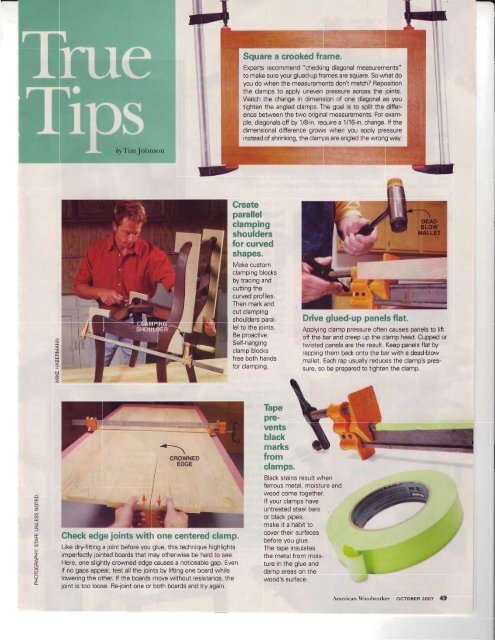AW #131.pdf - Karatunov.net
AW #131.pdf - Karatunov.net
AW #131.pdf - Karatunov.net
Create successful ePaper yourself
Turn your PDF publications into a flip-book with our unique Google optimized e-Paper software.
o<br />
5z<br />
a<br />
U<br />
J<br />
z<br />
l<br />
u'<br />
F<br />
T<br />
L<br />
E<br />
o<br />
tI<br />
L<br />
z<br />
E<br />
U<br />
@<br />
I<br />
U<br />
=<br />
Check edge joints with one centered clamp.<br />
Like dry-fitting a joint before you glue, this technique highlights<br />
imperfectly jointed boards that may otherwise be hard to see.<br />
Here, one slightly crowned edge causes a noticeable gap. Even<br />
if no gaps appear, test all the joints by lifting one board while<br />
lowering the other. lf the boards move without resistance, the<br />
.ioint is too loose. Re-joint one or both boards and try again.<br />
Square a crooked frame.<br />
Experts recommend "checking diagonal measurements"<br />
to make sure your glued-up frames are square. So what do<br />
vou do when the measurements don't match? Reposition<br />
the clamps to apply uneven pressure across the joints.<br />
Watch the change in dimension of one diagonal as you<br />
tighten the angled clamps. The goal is to split the difference<br />
between the two original measurements. For example,<br />
diagonals off by 1/B-in. require a 1/16-in. change. lf the<br />
dimensional difference grows when you apply pressure<br />
instead of shrinking, the clamps are angled the wrong way.<br />
Create<br />
parallel<br />
clamping<br />
shoulders<br />
for curved<br />
shapes.<br />
Make custom<br />
clamping blocks<br />
by tracing and<br />
.r ritinn fhA<br />
curved profiles.<br />
Then mark and<br />
cut cramprng<br />
shoulders parallel<br />
to the joints.<br />
Be proactive:<br />
Self-hanging<br />
clamp blocks<br />
free both hands<br />
for clamping.<br />
Tape<br />
pl€'<br />
ventS<br />
black<br />
marks<br />
from<br />
clamps.<br />
Drive glued-up panels flat.<br />
Applying clamp pressure often causes panels to lift<br />
off the bar and creep up the clamp head. Cupped or<br />
twisted panels are the result. Keep panels flat by<br />
rapping them back onto the bar with a dead-blow<br />
mallet. Each rap usually reduces the clamp's pressure,<br />
so be prepared to tighten the clamp.<br />
Black stains result when<br />
ferrous metal, moisture and<br />
wood come together.<br />
lf your clamps have<br />
untreated steel bars<br />
or black pipes,<br />
make it a habit to<br />
cover their surfaces<br />
before you glue.<br />
Tho lano incr rlatoc<br />
the metal from moisture<br />
in the glue and<br />
damn 2raaa nn tha<br />
wood's surface.<br />
American Woodworker ocToBER zooz 49










